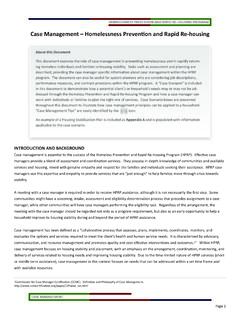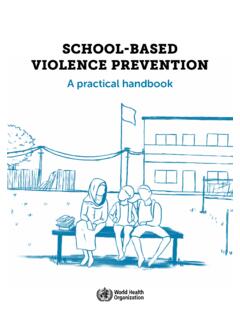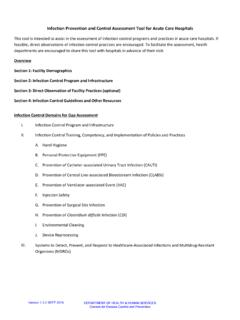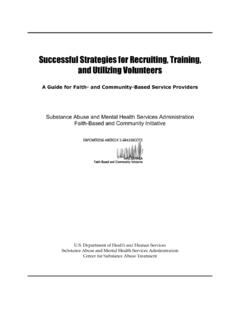Transcription of STOP SV: A Technical Package to Prevent Sexual Violence
1 STOP SV:A Technical Package to Prevent Sexual ViolenceNational Center for Injury prevention and Control Division of Violence PreventionSTOP SV: A Technical Package to Prevent Sexual Violence1 STOP SV: A Technical Package to Prevent Sexual ViolenceDeveloped by:Kathleen C. Basile, PhDSarah DeGue, PhDKathryn Jones, MSWK imberley Freire, PhDJenny Dills, MPHS haron G. Smith, PhD Jerris L. Raiford, PhD2016 Division of Violence PreventionNational Center for Injury prevention and ControlCenters for Disease Control and PreventionAtlanta, Georgia2 STOP SV: A Technical Package to Prevent Sexual ViolenceCenters for Disease Control and PreventionThomas R. Frieden, MD, MPH, DirectorNational Center for Injury prevention and ControlDebra E. Houry, MD, MPH, DirectorDivision of Violence PreventionJames A. Mercy, PhD, DirectorSuggested citation: Basile, , DeGue, S., Jones, K., Freire, K., Dills, J., Smith, , Raiford, (2016).
2 STOP SV: A Technical Package to Prevent Sexual Violence . Atlanta, GA: National Center for Injury prevention and Control, Centers for Disease Control and SV: A Technical Package to Prevent Sexual Violence3 ContentsAcknowledgements ..5 External Reviewers ..5 Overview of STOP SV ..7 Promote Social Norms that Protect Against Violence ..15 Teach Skills to Prevent Sexual Violence ..19 Provide Opportunities to Empower and Support Girls and Women ..23 Create Protective Environments ..26 Support Victims/Survivors to Lessen Harms ..29 Sector Involvement ..33 Monitoring and Evaluation ..34 Conclusion ..35 References ..36 Appendix ..42 Stock photo ID:54000268 STOP SV: A Technical Package to Prevent Sexual Violence5 AcknowledgementsWe would like to thank the following individuals who contributed in specific ways to the development of this Technical Package . We give special thanks to Linda Dahlberg for her vision, guidance, and support throughout the development of this Package .
3 We thank Division, Center, CDC leadership, and members of CDC Division of Violence prevention s Intimate Partner and Sexual Violence Workgroup for their careful review and helpful feedback on earlier iterations of this document. We thank Alida Knuth for her formatting and design expertise. Last but definitely not least, we extend our thanks and gratitude to all the external reviewers for their helpful feedback, support and encouragement for this ReviewersMark Bergeron-Naper Massachusetts Department of Public HealthCarrie Bettinger-Lopez White House, Office of the Vice PresidentAndrea Bright Missouri Department of Health and Senior ServicesAmalia Corby-Edwards American Psychological AssociationAndrea Hamor Edmondson Oklahoma State Department of HealthCraig Fisher American Psychological AssociationDonna Greco National Sexual Violence Resource CenterJennifer Grove National Sexual Violence Resource CenterSandra Henriquez California Coalition Against Sexual AssaultRosie Hidalgo White House, Office of the Vice PresidentDarlene Johnson Department of Justice, Office of Violence Against WomenDavid Lee California Coalition Against Sexual AssaultKat Monusky Washington Coalition of Sexual Assault ProgramsRebecca K.
4 Department of Health and Human Services, Administration for Children and Families, Family Violence prevention and Services ProgramLisa Fujie Parks prevention InstituteJen Przewoznik North Carolina Coalition Against Sexual AssaultKaren Stahl National Sexual Violence Resource CenterKiersten Stewart Futures Without ViolenceCaira M. Woods White House, Office of the Vice PresidentThe experts above are listed with their affiliations at the time this document was photo ID:63008935 STOP SV: A Technical Package to Prevent Sexual Violence7 Overview of STOP SV This Technical Package represents a select group of strategies based on the best available evidence to help communities and states sharpen their focus on prevention activities with the greatest potential to reduce Sexual Violence (SV) and its consequences. These strategies focus on promoting social norms that protect against Violence ; teaching skills to Prevent SV; providing opportunities, both economic and social, to empower and support girls and women; creating protective environments; and supporting victims/survivors to lessen harms.
5 The strategies represented in this Package include those with a focus on preventing SV from happening in the first place as well as approaches to lessen the immediate and long-term harms of SV. Though the evidence for SV is still developing and more research is needed, the problem of SV is too large and costly and has too many urgent consequences to wait for perfect answers. There is a compelling need for prevention now and to learn from the efforts that are undertaken. Commitment, cooperation, and leadership from numerous sectors, including public health, education, justice, health care, social services, business/labor, and government can bring about the successful implementation of this is a Technical Package ?A Technical Package is a compilation of a core set of strategies to achieve and sustain substantial reductions in a specific risk factor or Technical packages help communities and states prioritize prevention activities based on the best available evidence.
6 This Technical Package has three components. The first component is the strategy or the preventive direction or actions to achieve the goal of preventing SV. The second component is the approach. The approach includes the specific ways to advance the strategy. This can be accomplished through programs, policies, and practices. The evidence for each of the approaches in preventing SV or its associated risk factors is included as the third component. This Package is intended as a resource to guide and inform prevention decision-making in communities and Sexual Violence is a PrioritySV is a serious public health problem that affects millions of people each year. SV involves a range of acts including attempted or completed forced or alcohol/drug facilitated penetration ( , rape), being made to penetrate someone else, verbal (non-physical) pressure that results in unwanted penetration ( , Sexual coercion), unwanted Sexual contact ( , fondling), and non-contact unwanted Sexual experiences ( , verbal harassment, voyeurism).
7 2SV is highly prevalent. Approximately 1 in 5 women ( ) in the United States have experienced rape or attempted rape in their lifetime and have experienced other forms of SV. For instance, have experienced Sexual coercion, have experienced unwanted Sexual contact, and have experienced non-contact unwanted Sexual Although national prevalence studies indicate that women carry the greatest burden of SV over their lifetimes, men are also impacted by SV. Approximately 1 in 15 men ( ) have been made to penetrate someone at some point during their lives, have experienced Sexual coercion, have experienced unwanted Sexual contact, and have experienced non-contact unwanted Sexual As with other forms of Violence , some racial/ethnic and Sexual minority groups are disproportionately impacted by SV. Lifetime estimates of rape or attempted rape of women range from among multiracial women, among American Indian/Alaska Native women, among Black women, among non-Hispanic white women, to among Hispanic women.
8 Among men, of multiracial men, of Hispanic men, a quarter of American Indian/Alaska Native ( ) and Black men ( ), and of non-Hispanic white men have also experienced some form of SV in their Furthermore, among Sexual minorities, and of bisexual and lesbian women, respectively, have experienced rape at some point in their lives, and and , respectively, have experienced other forms of SV in their lifetime. Among men, bisexual men and gay men have experienced some form of SV other than rape in their STOP SV: A Technical Package to Prevent Sexual ViolenceSV starts early in the lifespan. Among women reporting a history of completed rape, 40% first experienced it before age 18, with more than 28% indicating they were first raped between the ages of 11 and 17; among men who were made to penetrate someone, 71% first experienced this before the age of 25, and experienced this before the age of While adolescence seems to be a period of high risk, college may also be a particularly vulnerable time.
9 In a large, cross-sectional survey of campus Sexual assault, 20% of the undergraduate women indicated that they had been a victim of SV since beginning SV is associated with several risk and protective factors. Risk for SV perpetration is influenced by a range of factors, including characteristics of the individual and their social and physical environments. These factors interact with one another to increase or decrease risk for SV over time and within specific contexts. Examples of key risk factors for SV perpetration include a history of child physical abuse, exposure to parental Violence , involvement in delinquent behavior, acceptance of Violence , hyper-masculinity, traditional gender role norms, excessive alcohol use, early Sexual initiation and Sexual risk-taking behavior ( , sex without a condom), and association with sexually-aggressive peer Poverty or low socioeconomic status,7 gender inequality,8 exposure to community crime and Violence , social norms supportive of SV and male Sexual entitlement, and weak laws and policies related to SV are also risk factors for SV ,9 Less is known about protective factors that is, factors that decrease or buffer the risk for SV.
10 However, the evidence suggests that greater empathy, emotional health and connectedness, academic achievement, and having parents who use reasoning to resolve family conflicts are associated with a lower risk of SV SV is connected to other forms of Violence . Research has demonstrated that experiences with SV are related to experiencing other types of Violence . For example, girls who have been sexually abused are more likely to suffer physical Violence and Sexual Violence re-victimization, and be a victim of intimate partner Violence later in In addition, perpetrating bullying in early middle school is associated with subsequent Sexual harassment Adolescents who have experienced forced intercourse at some point in their life are more likely than those who have not been forced to have intercourse to have thoughts of The overlap and co-occurrence of SV and other types of Violence may reflect the presence of shared risk factors across the multiple violent behaviors and experiences.















